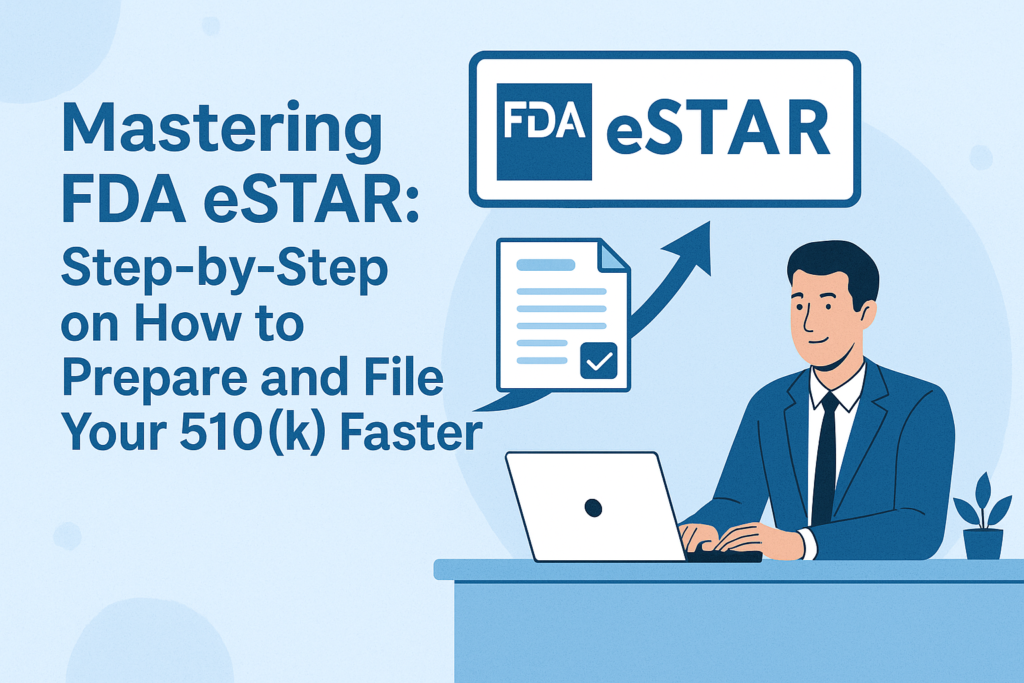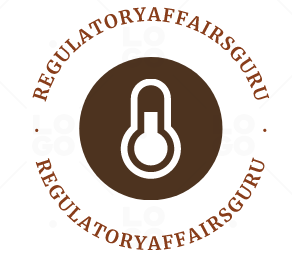
File Smarter with FDA eSTAR
What is FDA eSTAR?
eSTAR (Electronic Submission Template and Resource) is:
✅ Smart, interactive PDF template for preparing and submitting 510(k) and De Novo submissions.
✅ Guides you step by step, section by section, allowing you to enter all the data needed.
✅ In each section has embedded links to FDA guidance to avoid confusion.
✅ Automatically runs validation checks, catching mistakes before submission.
???? Why eSTAR Use is Important:
✅ Lowers Refuse-to-Accept (RTA) rejects by precluding all administrative and technical requirements.
✅ Lowers additional information (AI) cycles: removing back-and-forth delays.
✅ Harmonizes your submission format with FDA reviewer workflow, making your submission simpler and quicker to review.
✅ Prepares your organization for the FDA’s move toward completely electronic, structured submissions.
???? Step-by-Step Detailed Guidance on Creating Your 510(k) with eSTAR
1️⃣ Download the latest eSTAR template.
???? Go to the FDA eSTAR page.
???? Download the interactive 510(k) eSTAR PDF template.
???? Save a copy in the QMS-controlled project folder for traceability.
???? Have Adobe Acrobat or a similar program that can read interactive PDFs.
2️⃣ Read eSTAR Instructions Thoroughly
???? Before entering data, read the instructions embedded to determine required vs. conditional sections.
???? Sections automatically deactivate depending on your response (e.g., “Does your device have software?”).
???? Use the FDA guidance links supplied for every section to manage your data in line with regulatory requirements.
???? Don’t ignore instructions since bugs will be evident when later validation is carried out.
3️⃣ Fill in Administrative Sections
Contains:
✅ Submitter and official correspondent information (company name, address, DUNS).
✅ Contact person with phone, e-mail, mailing address.
✅ FDA Product Code, Regulation Number, and Classification.
✅ Submission type: Traditional, Abbreviated, Special 510(k).
Why it matters: The FDA utilizes this information to direct your submission through the FDA and reach you efficiently during the review.
4️⃣ Complete Device Identification
✅ Full Proprietary (brand) name and common name.
✅ Insert product code and regulatory classification.
✅ Enter your predicate device information:
Predicate name
510(k) number
Manufacturer
Why it matters: It determines the regulatory class of your device and is critical in establishing substantial equivalence.
5️⃣ Complete the descriptive Section: Device Description
✅ Provide a concise description of your device’s purpose, function, and technology.
✅ Use:
High-resolution labeled images and diagrams.
Materials and sizes.
Operating concepts (e.g., where measurements are made).
✅ In software-containing devices:
Define software operation.
Provide system architecture and workflow diagrams.
Why this is important: Tell the FDA reviewer what your device does and how it works to perform safety and efficacy evaluation.
6️⃣ Enter Indications for Use
✅ Fill in the FDA Form 3881 in eSTAR, which:
Sets forth what your device is to do.
Identifies the intended population and clinical conditions.
Corresponds precisely to your labeling and predicate indications.
Why this is important: Discrepancy here is a prime cause for rejection.
7️⃣ Add Labeling Materials
✅ Post:
Develop Instructions for Use (IFU).
Device labels per configuration.
Outer packaging labels.
✅ Match your Indications for Use and device description.
Why this matters: Label inconsistency or error is the most frequent cause of RTA rejection.
8️⃣ Full Performance Testing Data
✅ Upload:
Purpose and procedure protocols for bench test.
Complete test reports, including data, analysis, and pass/fail results.
A comparative test against your predicate device is used when applicable.
✅ Attach test reports to FDA-recognized standards.
Why this matters: It shows that your device is working safely and well under the conditions of intended Use.
9️⃣ Section on Biocompatibility (Where Applicable)
✅ If your device is going to come into contact with the patient:
Provide ISO 10993-1 compliant cytotoxicity, sensitization, irritation, and systemic toxicity test reports.
Provide test protocols, results, and GLP compliance certificates.
Provide a biocompatibility test matrix and the test endpoints.
Why this is relevant: Ensures patient safety and is mandatory for any device in contact with patients.
???? Sterilization and Shelf Life (If Applicable)
✅ Add:
Sterilization process and validation reports (EtO, Gamma, Steam).
SAL confirmation (typically 10⁻⁶).
Packaging validation (e.g., as per ISO 11607).
Real-time and accelerated aging studies for shelf-life.
Why it is relevant: Ensures your device is sterile upon delivery and is functional until the expiration date.
1️⃣1️⃣ Software and Cybersecurity Section (Where Applicable)
✅ Include:
Determine the Software Level of Concern, categorizing it as Minor, Moderate, or Major.
Included are architecture diagrams and functional descriptions.
Verification and validation (V&V) testing reports are also an integral part of the process.
The analysis of cybersecurity risks encompasses encryption, authentication, and update processes.
Why it matters: The FDA requires software-controlled or software-based devices to protect patients, ensure proper functioning, and defend against cyberattacks.
1️⃣2️⃣ Electrical Safety and EMC Section (if applicable)
✅ Include:
IEC 60601-1 test reports for electrical safety.
IEC 60601-1-2 EMC test reports.
Other relevant standard reports based on your device.
Why it matters: It guarantees your device is safely electric to operate and won’t interfere with or be interfered with by other devices.
1️⃣3️⃣ Declarations of Conformity
✅ Have signed declarations of conformity to FDA-recognized standards employed by your testing (e.g., IEC 60601, ISO 10993).
Why it’s essential: Streamlines review by confirming compliance with established standards, reducing additional justification requirements.
1️⃣4️⃣ Final Validation In eSTAR
✅ Use the eSTAR in-built validation tool to check:
Missing fields
Missing attachments
Section dependency discrepancies
✅ Fix all validation issues before submission to avoid RTA rejection.
1️⃣5️⃣ Submit Your eSTAR Submission
✅ Submissions are submitted by:
FDA’s CDRH Portal
FDA’s Electronic Submission Gateway (ESG)
✅ Check:
The PDF is interactive (do NOT print-scan or flatten).
File names are concise, FDA compliant, and match section titles.
Why this matters: The FDA requires an interactive eSTAR file to parse and review your submission quickly.
✅ eSTAR Success Best Practices
✅ Plan Ahead: Start filling in eSTAR sections as you generate data and reports.
✅ Keep Things Consistent: Maintain device name, indications, and model data consistent across each section and attachment.
✅ Remain with FDA Guidance: Direct every section to relevant guidance; show your data in response.
✅ QA Before Submission: Run the validation check repeatedly as you update.
✅ Train Your Staff: Get your staff very familiar with eSTAR workflows to reduce the learning curve within your staff.
???? eSTAR Benefits
✅ Reduced missing content issues
✅ Reduced FDA back-and-forth
✅ Shorter clearance timelines
✅ Future-proof your processes for FDA digital transformation
✅ Automated team processes
⚠️ Erasures to Refrain:
❌ Manual editing of eSTAR layout (fields or order)
❌ Flattened or scanned PDF
❌ Failed submission with errors that were not fixed still left invalidations
❌ Using legacy methods of submission when they should be submitting through eSTAR
❌ Device information inconsistency between sections
Example Case: Real World
A startup business preparing a 510(k) for a wearable respiratory monitor using eSTAR.
✅ Streamlined workflow allowed their QA, RA, and engineering teams to sync up.
✅ Omitting biocompatibility docs were identified by validation upfront.
✅ RTA-free submission was accepted, and the FDA approved it within 88 days.
Outcome: Early marketplace entry, lower regulatory cost, and enhanced investor trust.
